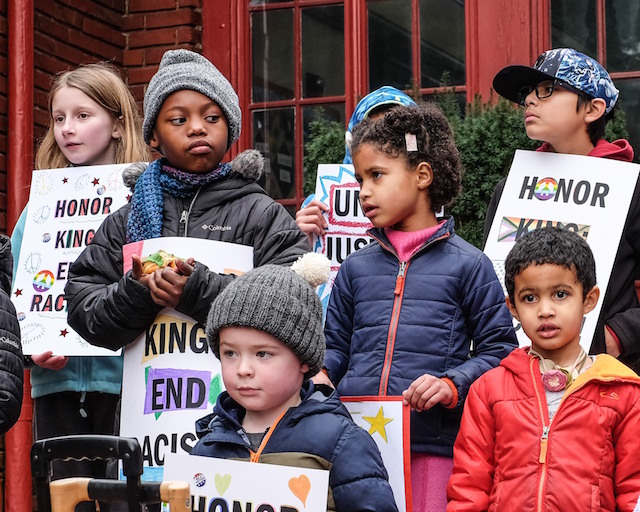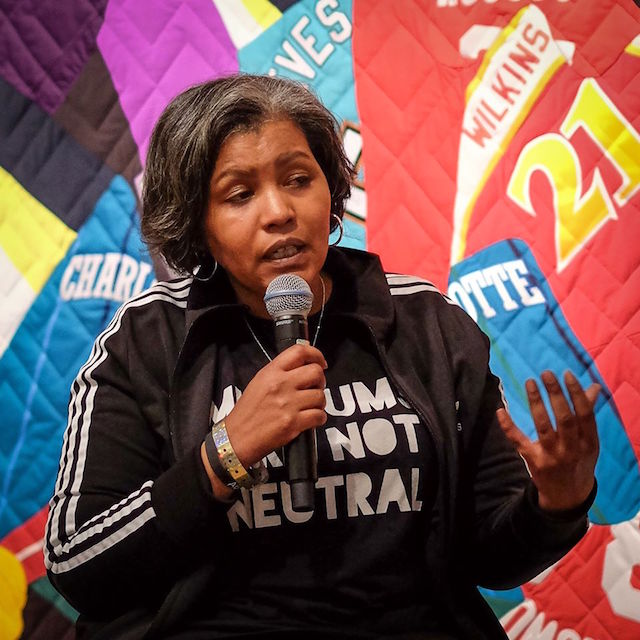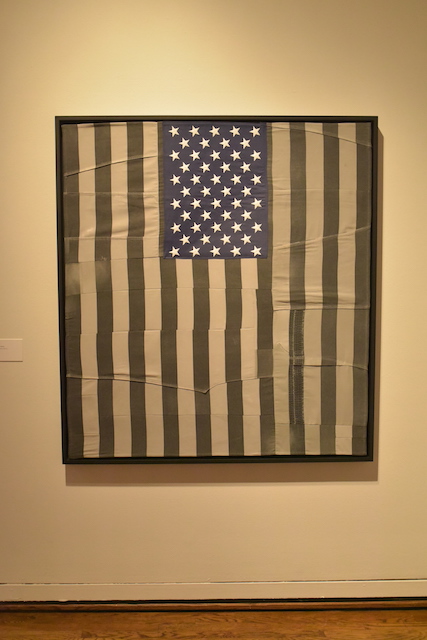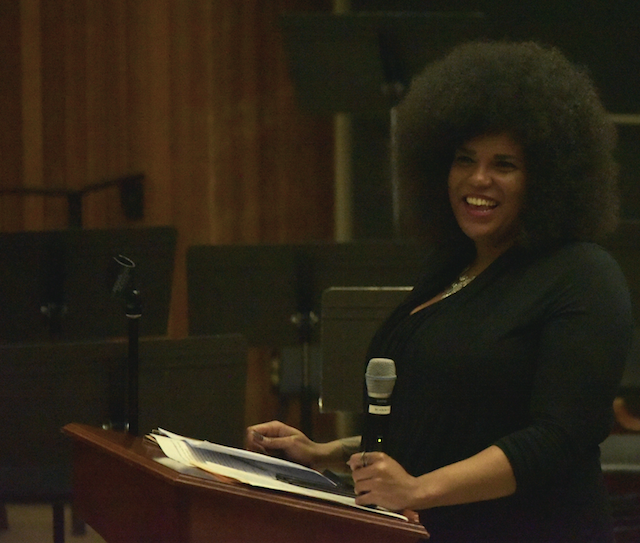
Story by Pete Shaw
Near the end of Walidah Imarisha’s presentation at the University of Portland’s inaugural MLK Day ON event, a man posed her a question reeking of defeat. He wondered just how people could possibly organize and achieve greater justice, and ultimately true freedom, without a leader such as King, whom he described in so many words as an extreme rarity. It was an odd inquiry as Imarisha had spent the better part of the past 75 minutes offering a version of her Why Aren’t There More Black People in Oregon? program tailor made for Martin Luther King Day that focused not so much on King, but on how throughout Oregon’s history, both prior to and following King’s lifetime, Black people had organized, organized, and organized to see through to a better world.
On the other hand, as Imarisha implied, the question had its own internal logic. How many times does the corporate media actually show the work numerous organizations, particularly those constructed by and composed of people of color, are doing to reach for that better world? Never mind that many of them are succeeding.
One of the pillars of capitalism, particularly virulent in the United States, is that it tries to force to the margins any movement seeking to disrupt or overthrow it. In some cases, those movements and their messages are co-opted so that what once distinctly stood in opposition to capitalism is used to promote it. As Woody Guthrie once said, you know it’s over when they put you on a postage stamp.
However, if you know where to look–say, at the communities whose existences are affected by unjust policies and practices–you will find numerous examples of resistance. Just because they don’t make the news does not mean they are not there. And in particular with King, just because the state and corporate sanctioned versions not only sanitize his vision, but give the impression that King did nothing following his rightly lauded 1963 March on Washington speech when he told tens of thousands of people about his dream, does not mean he was through speaking truth. That version of King ignores the man–as well as so many other people whose names never make the official history books–and his scathing critique of capitalism which as Imarisha noted, cannot be co-opted. And so one might be forgiven for believing King was murdered shortly after August 28, 1963, instead of April 4, 1968, a day after giving a speech to striking sanitation workers in Memphis, Tennessee, part of his larger Poor People’s Campaign.

However, that legacy remains even as the sanitized narrative is used for purposes King would likely have found grimly amusing. For example, while the United States Federal Bureau of Investigation on Monday sent out a Twitter message celebrating King, it failed to note its role in terrorizing King. It also failed to acknowledge its place in history as a terrorist organization dedicated to infiltrating and destroying all groups and movements working against capitalism and its attendant violence, bigotries, and depredations.
And where there is oppression, there is always resistance. Always.
On Monday at noon, Don’t Shoot Portland and Children’s Art and Social Justice held a rally at Peninsula Park that was attended by over 300 people. The steps leading to the Peninsula Park Community Center were adorned with various posters and canvas bags emblazoned with messages such as “Honor King: End Racism,” “Union Justice Now,” and “I Am Somebody.” That last one is a reference to the recent Hank Willis Thomas exhibit at the Portland Art Museum, All Things Being Equal.
Much of Thomas’s work showcases the connection between capitalism and bodies–especially Black ones–particularly the violence and racism that is essential to capitalism. Since the founding of the United States on land stolen from the indigenous population, Black people have been regarded as less than human, and their bodies as little more than disposable vessels for producing wealth for others, usually white men. The country was built on their backs and bones, their toil and sweat. As Thomas’s work shows, most glaringly in his use of various National Basketball Association players’ uniforms to create painstaking reconstructions of well-known paintings such as Picasso’s “Guernica” and Matisse’s “Icarus,” Black bodies are still used to produce wealth for others, although as Thomas shows, they often do not often achieve athletic glory. A US flag and another piece reading “We The People,” are composed of prison uniforms cut and sewn with Thomas’s intense attention to detail, a stark visual reminder of the integral role Black bodies play in the massive profits garnered by the prison industrial complex

Don’t Shoot Portland worked with Thomas and the Portland Art Museum during the exhibit’s three month run, which ended on January 12. Teressa Raiford, who founded Don’t Shoot Portland and who is a candidate for mayor, was instrumental in crafting various programs that worked with the Portland community to bring to life Thomas’s work. She has long understood the role art can play in education and in changing lives, and for many years now, Don’t Shoot Portland’s Martin Luther King Day rally and march has brought together both King’s vision and the artistic visions of young Portlanders, particularly, although certainly not limited to, young Portlanders of color.
Raiford, much like Imarisha, understands that any moment has the potential to be both a learning moment and a movement-building moment. Younger people led the march that followed the Don’t Shoot Portland rally, a route that went over to Martin Luther King, Junior Boulevard and followed it to the statue of King outside the Oregon Convention Center. Many, like the adults who flanked and followed them, held signs demanding the freedom that King worked toward. Both age cohorts carried canvas bags filled with socks, hats, gloves, and toiletries to be handed out along the march route to people who needed them. Reciting, or marching with signs bearing, King’s words regarding human dignity and the inherent value of human life is well and good. Putting those words into practice offers a far greater lesson, both in sharing that dignity and value, as well as offering a tutorial in movement building.
Imarisha, who is my Friend, spent most of her day at the University of Portland. I had not seen her in a few months, and I had forgotten how contagious her effervescence is. And somehow I had also forgotten just how impressive her mind is, her finely woven strands of thought as extraordinary as Raiford’s profound capacity for bringing people together.
As Imarisha spliced quotes from King with the history of Oregon and Portland, with a focus on the violence of and resistance to gentrification of Black neighborhoods and communities–always noting that gentrification is not a natural process, but rather one of a willful colonization–she insistently hammered home the point that without examining King’s ideas regarding capitalism, we cannot understand the United States, the City of Portland, and all points between. Her presentation, which time and again noted the resistance of Black people in Oregon to unjust racist laws and policies, was a reminder that not only is Oregon’s racist history a living legacy, but so is the resistance to that legacy.
What Imarisha and Raiford in their own ways convey is that the first step toward achieving a more just world is to center oppressed people. Imarisha told the audience, “If we can’t see the organizing that is happening, then we’re not looking in the right place…. When oppressed people are centered, they create institutions that make communities healthier and stronger.”
Local musical artists contributed to both events, and to the final weekend of the Hank Willis Thomas exhibit. Julianne Johnson opened and closed Imarisha’s talk, backed by The University singers. Johnson also performed a duet with university student rapper Sharif Morton. LaRhonda Steele sang at the Don’t Shoot Portland event at Peninsula Park and a week earlier at the Portland Art Museum. Both Johnson and Steele employed their voices to lift to the heavens the spirituals associated with the Civil Rights Movement, made anew for these times when the fight for freedom for all is still critical.

In the end, the events asked the question that King posed: which side are you on? Or as Imarisha put it, centering the question squarely in the present moment, “We will stand with white supremacist fascists, or we will stand with people fighting for freedom and justice. It is our only choice.”
Imarisha and Raiford are just two people in Portland working toward realizing King’s vision of true freedom. In fact, Imarisha projected a long list of local organizations that in order to fill the display screen in the auditorium had to appear so small as to be barely readable.
The point was made: you just have to know where to look.
For more information on how to get involved with Don’t Shoot Portland, please go to: https://www.facebook.com/DontShootPDX/
For a video of Walidah Imarisha’s Why Aren’t There More Black People in Oregon presentation, please go to: https://www.youtube.com/watch?v=7Lcm1LDZZXg
To see Imarisha’s Oregon Black History Timeline, please go to: https://www.youtube.com/watch?v=fo2RVOunsZ8






